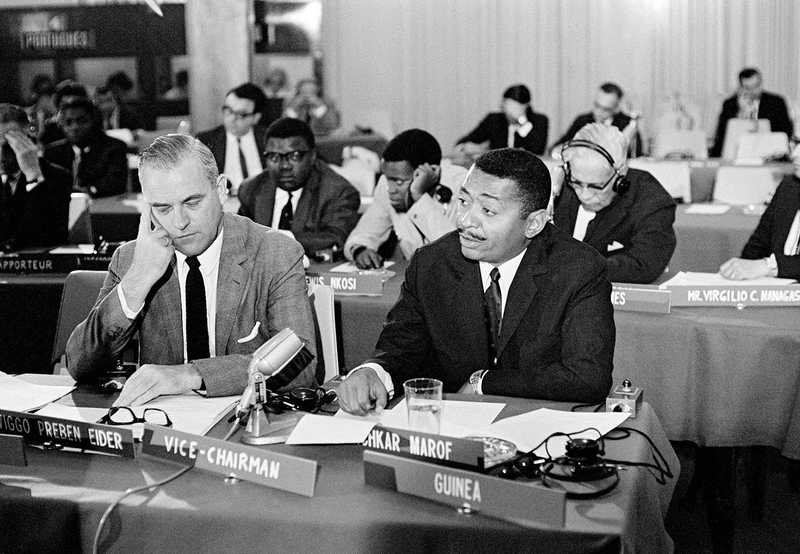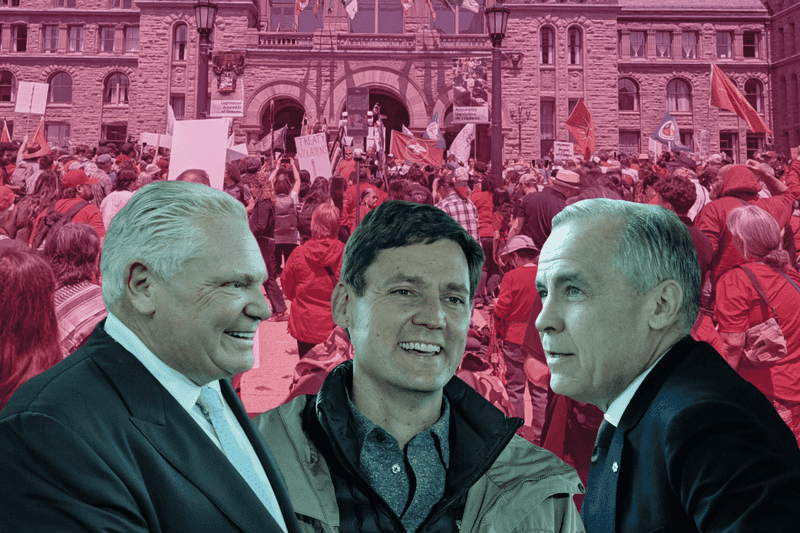
“The spirit of the barbarians, which the Western peoples thought they had tamed by centuries of struggle, is abroad again and threatens to destroy the civilizing work of all these centuries.”
– Wilhelm Röpke, Against the Tide1“The barbarians, when they come, will legislate.”
– C.P. Cavafy, Waiting for the Barbarians2
1974 was a banner year for the United Nations General Assembly (UNGA), and the passage of the NIEO declaration was its crowning glory.3 Many saw the NIEO as laying the foundation for economic self-determination that would ensure that political self-determination was not just a formalist achievement but a substantive realization that finally turned the chapter on a euro-centric economic architecture. Within the context of the UN, the NIEO was a radical intervention that epitomized the paradoxical subject position of anti-colonial sovereignty in that moment — seeking inclusion in a world order that they wanted to transform.
In the early decades of the UN, post-colonial states may have been largely united in the emancipatory euphoria of having defeated European colonialism, but these states were not characterized by a corresponding ideological unity on their future economic path and whether they defined their economic horizon within the terms of global capitalism, or through resistance to those terms. Given this diversity, passage of the NIEO declaration in the GA was a remarkable achievement. However, it was, in fact, only one of a series of remarkable GA resolutions in 1974. That same year, the GA passed Resolution 3236, which affirmed the inalienable rights of the Palestinian people to self-determination, national independence and sovereignty, and the right of Palestinians to return to their homes and property. Most significantly, it was followed that same day by Resolution 3237, which gave the PLO observer status. South Africa was also suspended from the GA in 1974. Indeed, that year, South Africa was nearly ousted from the United Nations altogether when the GA forwarded a resolution asking the council to review South Africa’s membership and it was only the triple veto of the US, UK and France that ensured the apartheid state was not expelled.
In the twin actions of including the PLO and suspending South Africa, the GA was already ahead of today’s conversation about apartheid as not just a system of racist governance, but a system of racist colonial governance. Finally, it is worth highlighting that 1974 was also the year when the GA passed Resolution 3292, requesting that the International Court of Justice (ICJ) give an advisory opinion on the decolonization of the Western Sahara.4 The judgement on the Western Sahara presented the first international judicial ruling challenging the coherence and legitimacy, legal or otherwise, of the notion of terra nullius that had been mobilized in the material dispossession of indigenous people across the globe, from the Americas to Australia. The NIEO itself gave voice to this recognition (although in a telling statist register) when it gave a prominent place to the “full permanent sovereignty of every State over its natural resources and all economic activities.”5 From apartheid to settler colonialism, the GA of that period was abuzz with reformist projects taking on the unfinished work of decolonization processes on multiple fronts. This was the milieu from which the NIEO declaration emerged in 1974.
The NIEO is often written about in terms of the alternative economic visions at stake, including its provoking of a disciplinary and professional backlash in influential sectors of ‘global north’ based economists that led to their abandoning the received wisdom of Keynesianism to embrace neoliberalism. Indeed, neoliberalism’s new dawn in the 1970s is partly tied to this economic debate and opposition to the NIEO’s alternative economic analysis and prescriptions. But a focus on the economic domain does not tell the whole story. The neoliberal economic vision was intricately intertwined with a vision of the social order of international society, a vision that was grounded in a racial and civilizational vision of governance and expertise. The opposition to the NIEO’s economic policy vision is inextricably tied to this social vision and the post-imperial dynamics of global governance that the 1974 GA represented. The NIEO resolution trumpeted that the “colored peoples” of the world were seizing the reins of power.6
At the 1955 Bandung conference, President Sukarno’s welcoming speech noted that the conference was the largest gathering of “colored peoples” from across the world. Partha Chatterjee has argued that the real significance of Bandung was that this gathering translated into the formal equality of nations, colonial and post-colonial alike. For Chatterjee, sovereign equality at the GA is the institutional embodiment of a Bandungian ethos for democratic governance of international affairs.7 Twenty-nine governments were represented at Bandung in 1955. Twenty years later, when the NIEO declaration was passed, there were 139 governments represented in the GA — the majority of which were newly independent nations. This decisive and determined trajectory was anticipated in 1955 — emboldening to the formerly colonized, and threatening to the formerly colonizing.
The German economist Wilhelm Röpke, a key figure in what was to become the Geneva school of neoliberalism, shared Chatterjee’s reading about the significance of sovereign equality. But for him, this was threat, not promise. Like the elder statesmen of Bandung — Sukarno, Nehru, Nasser — Röpke didn’t live to see the 1974 GA in action. However, if the NIEO was the crowning achievement of Bandung, the neoliberal counteroffensive to Bandung was the crowning achievement of Röpke and his Mont Pellerin Society cohort. In 1955, the same year as the Bandung conference, Röpke marked the threat of the tidal wave of new sovereigns and urged that “one of the urgent needs of our time” was precisely “to diminish national sovereignty” so that countries without the “moral infrastructure” for the global marketplace did not control the direction of global society.8 For Röpke, holding off the barbarians at the gate by diminishing national sovereignty was not a project of shifting authority to a contender for global sovereign power like the GA but of creating the infrastructure for a neoliberal economic order. The GA was drowning out Europe’s voice; the tyranny of the majority, trumping over civilizational expertise. For Röpke, champion of apartheid South Africa, the 1974 GA would have been exhibit A – the same GA that passed the NIEO created a seat at the table for Palestine, while showing South Africa the door.
Protesters against the PLO resolutions at the gates of the UN in 1974 complained about this new composition of the GA and its threat to world order.9 Röpke was not alone in his fears about the newly empowered third world. Achille Mbembe characterizes this period as one of “anti-third world Eurocentrism” that emerged into the global public sphere in the 1950s but “reached its apogee in the 1970s in the critique of dependence and unequal development theories and the attempts to establish a more just international economic order.”10 In Mbembe’s historical taxonomy, it is a period that follows “primitive Eurocentrism” of the imperial age, and one that precedes the “late-Eurocentrism” that came with the consolidation of neoliberalism. Indeed, one can see the late 1970s, after the defeat of the NIEO, as a kind of interregnum where the bloom of decolonization was in decay and ‘things fell apart.’11
For Röpke, Hayek and others in their cohort, decolonization was what was bringing about the dissolution of the center, and it is a world governed by these new sovereigns that was a threat to civilization and the old world order. The global market on the other hand could be a buffer zone, mediating the collective force of these new sovereigns. In Quinn Slobodian’s words, the neoliberal notion of the market represented a “militant globalism” that was “based on institutions of multi-tiered governance that are insulated from democratic decision making.”12 Democracy had two references here. Firstly, it referred to the masses of these new nation states; they had been rendered indigent by colonialism and exerted pressure on their political leaders to enact policies that would facilitate greater redistribution. It also referred to democracy on a world scale in institutions of global governance such as the GA. The 1974 resolutions were a testament to the fact that the “colored peoples” of the world, having entered the gates, had forged solidarities that mobilized their GA majority to legislate towards alternative futures. Racialized fears of this collective force played a constitutive role in neoliberal economic analysis. Neoliberalism was not just a set of economic policies that majority white countries advanced; rather, neoliberalism was itself an expression of white supremacy; the neoliberal marketplace was the final defense against the movement of “colored peoples…towards Bethlehem” in greater and greater numbers.

The pivotal contrasts between the dependency-theory-inflected NIEO economic vision (“a new deal for the world”) and the neoliberal one was evident in the different agendas for the distributive consequences – racial and otherwise – of these alternative programs for world order. Crucially, there were also differences in the disciplinary knowledges and policy expertise that framed and analyzed strategic choices and trade-offs. Thus, each of the divergences in particular policy orientations (for instance, the advisability of sovereigns enacting tariff controls and establishing subsidies for local industries) can be situated in contrasting analytic orientations in the study of the political economy of development. For instance, the overarching economic vision of the NIEO leaned towards sovereigns being empowered to enact such policy measures in choosing partial and strategic engagement with the global market while aiming for the telos of economic self-sufficiency as a framing goal in development planning. The people of the third world were seeking to change the rules of global governance, and the new rules proposed by the NIEO emerged from an alternative analysis of global markets. The NIEO’s framework was informed by the work of third world economists such as the Argentinian Raúl Prebish who was the first Executive Secretary of the UN Economic Commission for Latin America (CEPAL); CEPAL emerged as a central incubator for the ideas that informed the NIEO by analyzing how global markets engendered dependency, and how dependency was a mechanism for neocolonial exploitation.13 Prebisch himself would then go on to become the first Secretary General of the United Nations Conference on Trade and Development (UNCTAD), which expanded beyond Latin America to play a pivotal role as a central think tank for what became the NIEO. The Sri Lankan economist and diplomat Dr. Gamini Corea created the Group of 77 at the first UNCTAD meeting in 1964 to help secure a collective ‘third world’ presence in the global public sphere; Corea became the third Secretary General of UNCTAD in 1974 when the NIEO declaration was passed. CEPAL and UNCTAD were institutional avenues to decolonizing the politics of knowledge in the field of political economy and development. The ‘thirdworldist’ economic policy networks that they drew on and mobilized prioritized the interests of the global south in the analysis of world systems. This vibrant heterodoxy in economic thought can itself be situated in a larger milieu of postcolonial theorizing in the 1970s with critical interventions such as Walter Rodney’s How Europe Underdeveloped Africa and Edward Said’s Orientalism emerging in this same period.14
The political promise and intellectual insights of the NIEO did not represent an isolationist and atavistic nationalism but a nationalism embedded in a vision of transnational solidarities and future-oriented collective action to transform the institutional arrangements of international society. Indeed, all the GA resolutions of 1974 give expression to this fundamentally optimistic tricontinental internationalism. The neoliberals may also be called internationalists, but their globalism stood in opposition to the third world emphasis on national economic planning and its reading of the pernicious dynamics of neocolonial dependency. The central directive of the neoliberal vision was of market driven interdependence – or, in Slobodian’s language, “encasement of the market in a spirit of militant globalism.”15 Moreover, this globalism was one where racism was baked into the universal only to emerge again in notions of economic expertise, good governance and failed states, with the alternative internationalism of the “colored peoples” of the world rendered inaudible.
Today, some analysts of rightwing politics and policies argue that there is an internal tension between neoliberalism and white supremacy; they posit a dichotomy of the universalist rationalities of the market v. the particularist rationalities of racism. Accordingly, a familiar framing of this landscape describes neoliberalism as race-neutral and technocratic in vision (even if not in consequence); in contrast, white supremacy is described as fundamentally anti-technocracy, and hostile to social scientific knowledge. The history and circumstance of the GA resolution in support of the NIEO in 1974 allows us to better understand how this framing of the political and intellectual landscape does not fully capture the racial-capitalist grammar that is internal to both neoliberalism and white supremacy. The economic ordering of the world and the racial ordering of the world cannot be so easily disentangled. As captured so pithily by Ruthie Gilmore, “capitalism requires inequality and racism enshrines it”; the NIEO was an effort to contest that inequality and the distribution of resources and meanings that enshrined it on a global scale. It represented a radical material redistribution of economic resources but also of the social capital that was part of the infrastructure of global governance. Most significantly, the social capital at stake included both the racial composition of who sat in the GA in 1974, as well as the intellectual traditions of economic knowledge and development policy networks that informed the agendas of those around the table.
Advocates of the NIEO recognized that the continuities from colonial to postcolonial world orders included the racial hierarchies and distinctions that shaped economic thought and macro-economic planning. A monopoly on these domains (on what constituted ‘expertise’ and what defined economic ‘knowledge’) were part of the “wages of whiteness” that had been delivered by centuries of slavery and colonialism that had made up the old economic order – or in Röpke’s words, the “civilizing work of all these centuries.”16
Significantly however, the continuities from colonial to postcolonial world orders include resistance to the racial hierarchies and distinctions that shape economic thought and macro-economic planning in insurgent projects today.17 The wages of resistance include the inheritance of traditions that inform and inspire radical political imagining of alternative world orders.18 For instance, one might connect the dots from the spirit of tricontinental internationalism that infused the NIEO with the World Social Forum that emerged from Porte Alegre (and elsewhere) at the beginning of the new millennia.19 In a similar vein, one can hear echoes of the NIEO’s commitment to economic self-determination in the networks of cooperative economics and mutual aid networks that are proliferating in different parts of the world from City Plaza and other migrant squats in Southern Greece,20 to Dalia and initiatives for food sovereignty in the West Bank,21 to the “cooperative commonwealth” in Jackson, Mississippi.22 Relatedly, one could track continuities between the NIEO and contemporary calls for reparations for the slave trade and colonialism that resist and unsettle the regime of trade and aid that shape economic precarity and climate injustice today.23 These boldly visionary initiatives may resonate with the insurgent and decolonial spirit of the NIEO but they are not nostalgia projects limited by the narrowly statist vision of the 1970s. Rather, they speak to the historical conjuncture of the current moment. Their strengths include the fact that they are responsive to local priorities, led by local social movements, and animated by transnational solidarities. Whether they can also be the foundation for new transnational solidarities and a new international economic order is the challenge that lies ahead.

Vasuki Nesiah is Professor of Practice at the Gallatin School of Individual Study at New York University.



